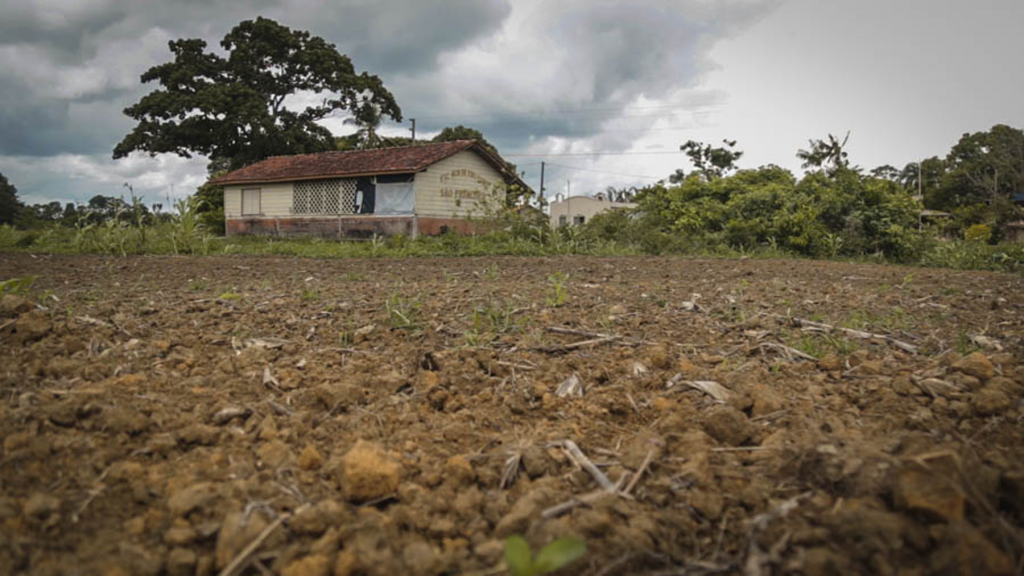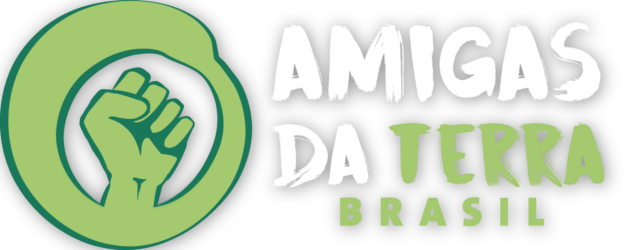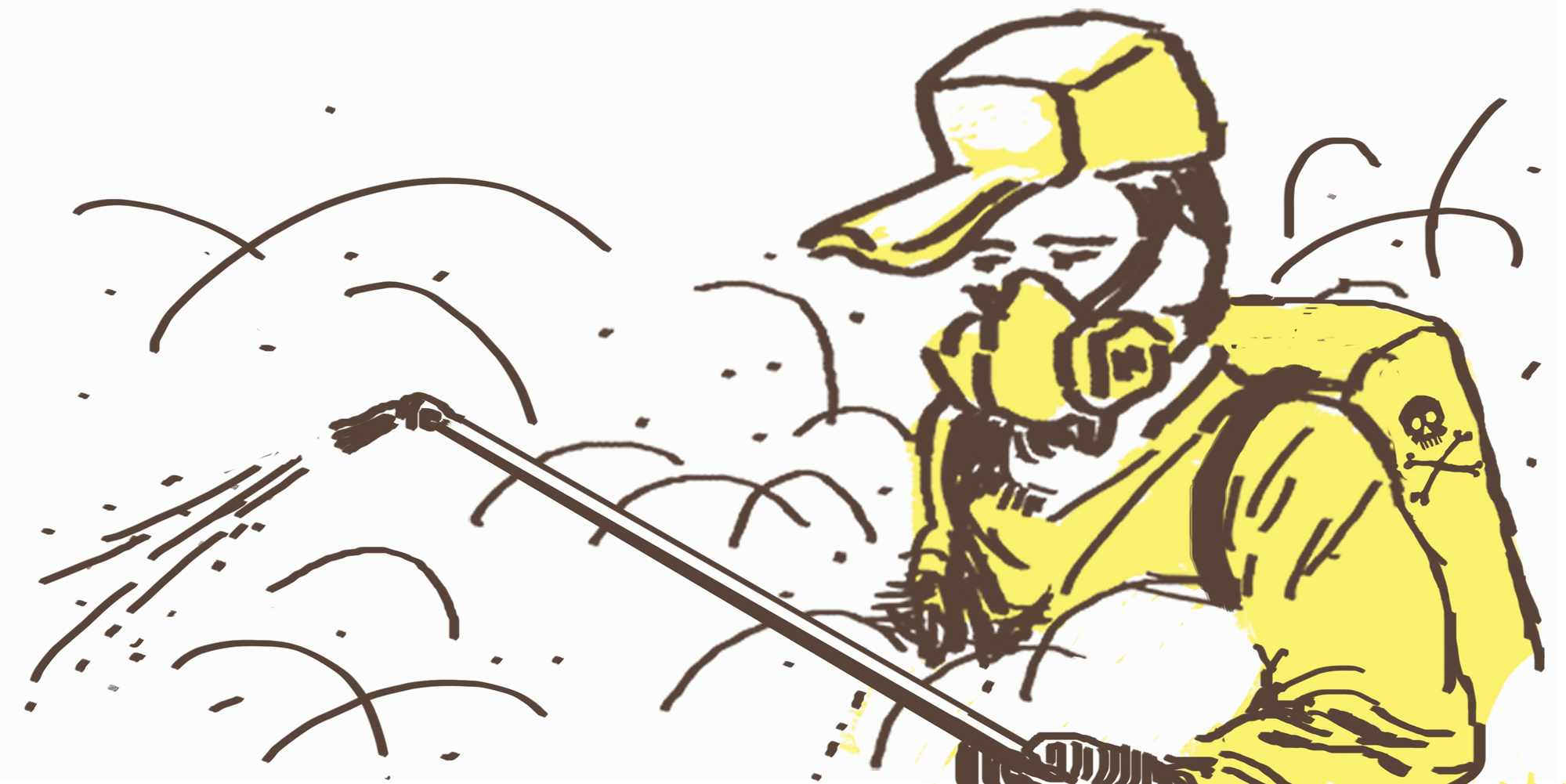Above Tiningu and Bom Jardim communities, one reaches the Curuaúna region. Poison oozes from the vast soy fields towards the quilombos and the waters of the Maicá River.
Driving and walking around the region, Francinaldo Miranda, member of the Union of Rural Workers and Family Farmers of Santarém (STTR-STM), shows the skillful architecture of soybean farmers, or perhaps the skill in design of environments – This is the “puxadinho”, which comes down to a small advance – no more than two or three meters – from the soybean field towards the standing forest; then the forest is burned little by little year by year as if nothing is happening. Slowly soy takes up all the available space – as if it needed to grow more: today, it can be said that in the middle of the soy field there’s a forest (there’s a forest in the middle of the soybean field) – And they build this “wall” so that the view of the road is blocked. Nobody sees anything and the forest seems to be alright. The wall in question is a thin strip of trees that does fulfill its role: it is only by going around it that one can contemplate the immensity of soy – soy to be lost sight of, on one side, on the other side, ahead and behind. However, from the road, it is as if the trees were still standing tall.
This is one of the stories of “What really happens in the Amazon Forest”. Browse content:
INTRODUCTION
Part 1 (central page): What really happens in the Amazon Forest
Part 2: Who is favored by Bolsonaro’s responses to the fires?
Part 3: The “win-win” of companies with the financialization of nature
Part 4: But after all, who is behind these crimes?
STORIES
1) The siege explained on a map
2) A port stuck in the “mouth” of the river
3) Before the port arrives (if it does), the impacts already did
4) Health center and quilombola school: the struggle changes life
5) [you are here] Curuaúna: on one side, soy. On the other? Soy also
6) A face printed on a T-shirt
The impacts on the forest and on local communities are tremendous: soy represents land grabbing, fires, deforestation, vast use of pesticides, in addition to needing an entire infrastructure for its transport and export, which also impacts the peoples of the region. But some cases reach the absurd: as the situation of a small school in the community of Boa Sorte (and the name seems a sadistic irony of life: Boa Sorte means “good luck” in English). The distance between the classroom window and the soybean field does not reach two meters, and the most serious: the use of pesticides does not respect school hours and is repeated several times a year. Contamination of children is direct and repeated.
The Curuaúna region is so impacted by the use of pesticides (the main one is glyphosate – Monsanto’s Round-Up) that blood has been collected from residents and studies are being carried out to measure the size of the damage to people’s health. The results of this research have not yet been released. Other studies, however, are available: this is the case of the dissertation by Nayara Luiz Pires, from the University of Brasília, who in 2015 researched the expansion of the agricultural frontier in the Amazon and the contamination by glyphosate in the Santarém region. In it, the researcher states “a probable risk of human exposure to pesticides, mainly through the respiratory tract“.





Soy “ghost-towns”
Many families do not wait to find out how harmful pesticides are and how fast they are killing them. Thus, communities are gradually being abandoned, disappearing from the map, ceasing to exist – There was a football field here, – There were a lot of houses there, – Here was a school, shows Francinaldo as you go along the road that cuts through the fields of soy.
Even the traditional football matches between neighboring communities are in danger of not happening anymore, simply because ghost towns do not have football teams: no one else will be able to challenge the feared São Jorge, the team to be beaten in the region. Francinaldo, a native of the Curuaúna area, was a goalkeeper and tells when – The striker was just a few meters from me and was one of those who kicked hard, my friend even, but he kicked with anger, and the ball was so fast, but so fast, that it tore Francinaldo’s belly, what he only discovered later, after the match, as he dragged himself with the bike home so as not to accuse the pain in front of the opponent. It even required surgery and it took years to fully recover. Most importantly, however, he succeeded: he defended the kick.
Thay’s what the advance of agribusinness and monocultives mean: in addition to death and contamination and land grabbing, the end of culture and local life.
Return to the central page “What really happens in the Amazon Forest”
Also read parts 2, 3 and 4 of the introduction:
– Who is favored with Bolsonaro’s responses to the fires?
– The “win-win” of companies with the financialization of nature
– But after all, who is behind these crimes?
And the stories:
– The siege explained on a map
– A port stuck in the “mouth” of the river
– Before the port arrives (if it does), the impacts already did
– Health center and quilombola school: the struggle changes life
– [you are here] Curuaúna: on one side, soy. On the other? Soy also
– A face printed on a T-shirt


